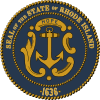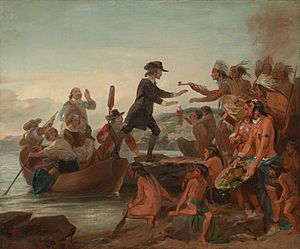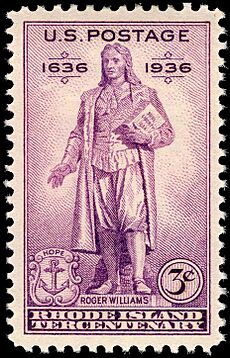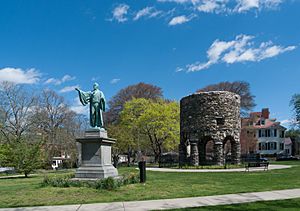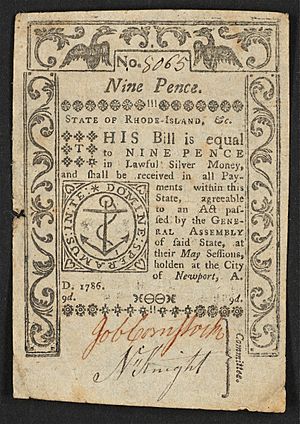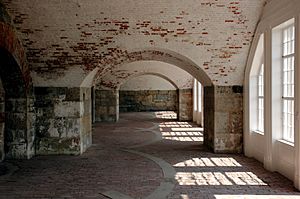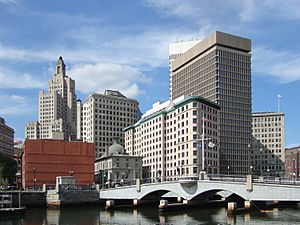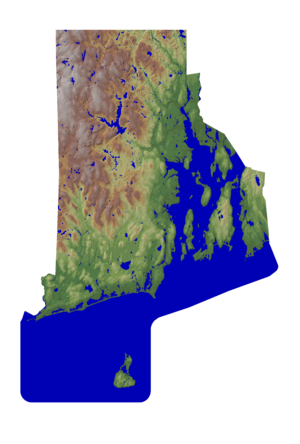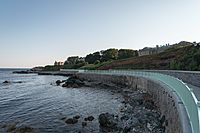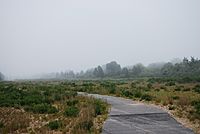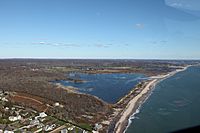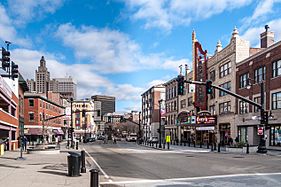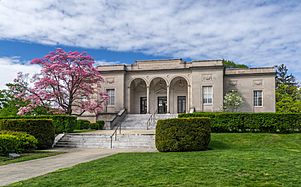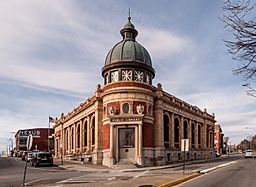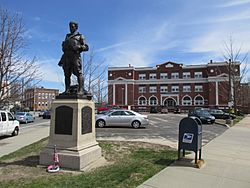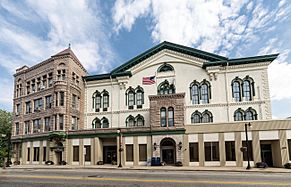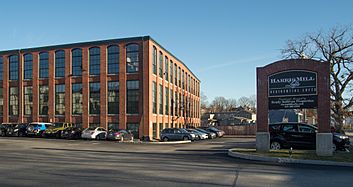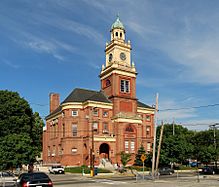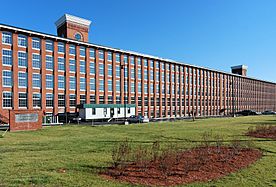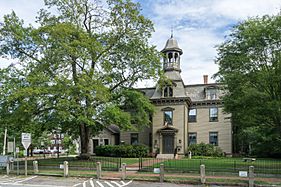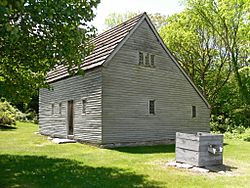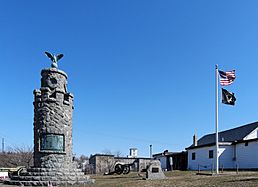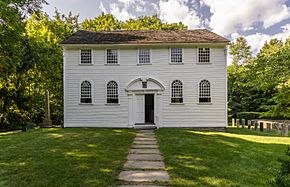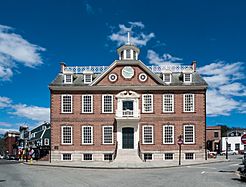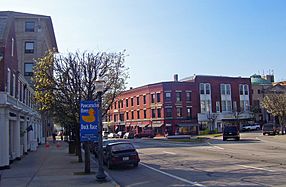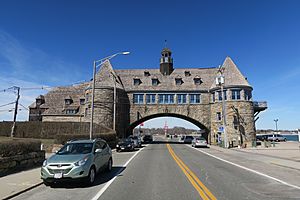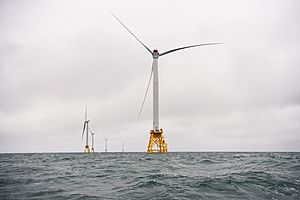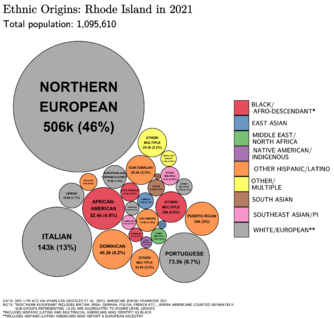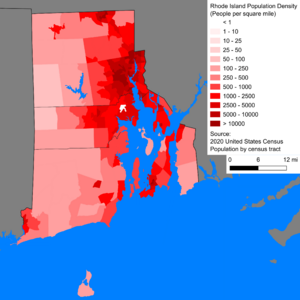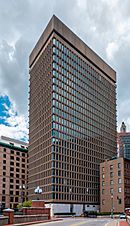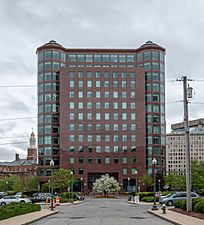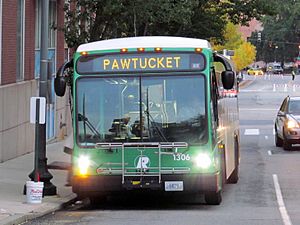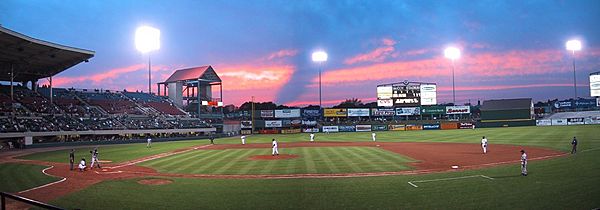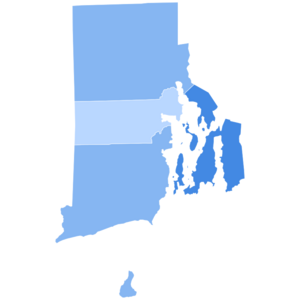Rhode Island facts for kids
Quick facts for kids
Rhode Island
|
|||
|---|---|---|---|
|
|||
| Nickname(s):
The Ocean State
Little Rhody |
|||
| Motto(s):
Hope
|
|||
| Anthem: "Rhode Island's It for Me" | |||
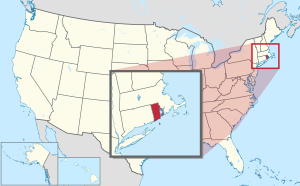
Location of Rhode Island within the United States
|
|||
| Country | United States | ||
| Before statehood | Colony of Rhode Island and Providence Plantations | ||
| Admitted to the Union | May 29, 1790 (13th) | ||
| Capital (and largest city) |
Providence | ||
| Largest county or equivalent | Providence | ||
| Largest metro and urban areas | Greater Boston (combined) Providence (metro and urban) |
||
| Legislature | Rhode Island General Assembly | ||
| • Upper house | Senate | ||
| • Lower house | House of Representatives | ||
| Judiciary | Rhode Island Supreme Court | ||
| U.S. senators | Jack Reed (D) Sheldon Whitehouse (D) |
||
| U.S. House delegation | 1: Gabe Amo (D) 2: Seth Magaziner (D) (list) |
||
| Area | |||
| • Total | 1,545 sq mi (4,001 km2) | ||
| • Land | 1,034 sq mi (2,678 km2) | ||
| • Water | 511 sq mi (1,324 km2) 33.1% | ||
| Area rank | 50th | ||
| Dimensions | |||
| • Length | 48 mi (77 km) | ||
| • Width | 37 mi (60 km) | ||
| Elevation | 200 ft (60 m) | ||
| Highest elevation | 812 ft (247 m) | ||
| Lowest elevation
(Atlantic Ocean)
|
0 ft (0 m) | ||
| Population
(2024)
|
|||
| • Total | |||
| • Rank | 44th | ||
| • Density | 1,006/sq mi (388/km2) | ||
| • Density rank | 2nd | ||
| • Median household income | $85,000 (2023) | ||
| • Income rank | 14th | ||
| Demonym(s) | Rhode Islander | ||
| Language | |||
| • Official language | De jure: None De facto: English |
||
| Time zone | UTC−05:00 (Eastern) | ||
| • Summer (DST) | UTC−04:00 (EDT) | ||
| USPS abbreviation |
RI
|
||
| ISO 3166 code | US-RI | ||
| Traditional abbreviation | R.I. | ||
| Latitude | 41° 09′ N to 42° 01′ N | ||
| Longitude | 71° 07′ W to 71° 54′ W | ||
Rhode Island is a state in the New England region of the Northeastern United States. It shares borders with Connecticut to the west and Massachusetts to the north and east. To the south, it meets the Atlantic Ocean through Rhode Island Sound and Block Island Sound. It also has a small water border with New York.
Rhode Island is the smallest U.S. state by area. It is also the seventh-least populous state, with over 1.1 million people as of 2024. However, it is the second-most densely populated state after New Jersey. The state gets its name from Aquidneck Island, but most of its land is on the mainland. Providence is its capital and largest city.
Native Americans lived around Narragansett Bay before English settlers arrived in the early 1600s. Rhode Island was special among the Thirteen Colonies because it was founded by Roger Williams. He was a refugee who escaped religious persecution in the Massachusetts Bay Colony. He wanted to create a safe place for religious freedom. In 1636, he founded Providence on land bought from local tribes. This was the first settlement in North America with a government that was separate from religion. The Colony of Rhode Island and Providence Plantations became a place for people who had different religious or political ideas.
Rhode Island was the first colony to ask for a Continental Congress in 1774. It was also the first to declare its independence from the British Crown on May 4, 1776. After the American Revolution, Rhode Island became the fourth state to approve the Articles of Confederation on February 9, 1778. Its citizens wanted a weaker central government. Because of this, they did not attend the 1787 meeting that wrote the Constitution of the United States. Rhode Island was the last of the original 13 states to approve the Constitution, doing so on May 29, 1790.
The state was officially called the State of Rhode Island and Providence Plantations for a long time. However, it was usually just called "Rhode Island." On November 3, 2020, voters approved a change to the state constitution. This officially removed "and Providence Plantations" from its full name. The state's official nickname is the "Ocean State." This is because it has about 400 miles (640 km) of coastline. Large bays and inlets make up about 14% of its area.
Contents
The Name of Rhode Island
How Rhode Island Got Its Name
Even though it's called "Rhode Island," most of the state is on the mainland. Its official name was State of Rhode Island and Providence Plantations from 1636 until 2020. This name came from combining early settlements around Narragansett Bay. The settlements of Rhode Island (Newport and Portsmouth) were on Aquidneck Island, also known as Rhode Island. Providence Plantations referred to settlements on the mainland like Providence and Warwick.
It is not fully clear how the island got the name Rhode Island. Two historical events might have influenced it:
- Explorer Giovanni da Verrazzano saw an island near Narragansett Bay in 1524. He thought it looked like the island of Rhodes in Greece. Later explorers could not find the exact island Verrazzano described. However, the colonists who settled the area believed it was this island.
- Adriaen Block sailed past the island in the 1610s. In 1625, he described it as "an island of reddish appearance." In Dutch, this was "een rodlich Eylande." This Dutch phrase might have changed into "Rhode Island." Historians think the "reddish appearance" came from red autumn leaves or red clay on the shore.
The first time "Rhode Island" was written down for Aquidneck Island was in 1637 by Roger Williams. The name was officially given to the island in 1644. Dutch maps from 1659 also called the island "Red Island" (Roodt Eylandt).
Changes to the State's Name
The first English settlement in Rhode Island was Providence. The Narragansett gave this land to Roger Williams in 1636. Williams did not get permission from the English king at first. He believed the English had no right to Narragansett and Wampanoag land.
In 1643, Williams traveled to London during the English Civil War. He wanted to get legal recognition for the new settlements. A special document was given to "the incorporation of Providence Plantations in Narragansett Bay in New England." After the English Civil War, a Royal Charter was given in 1663. This charter officially named the colony the "Governor and Company of the English Colony of Rhode Island and Providence Plantations, in New England, in America." After the American Revolution, the new state became the "State of Rhode Island and Providence Plantations" in 1790. But for convenience, people usually just called it "Rhode Island."
The word plantation in the state's name became a topic of discussion in the 1900s. People became more aware of slavery and its role in Rhode Island's early history. In 2009, the state's General Assembly voted to hold a public vote in November 2010. This vote was about removing "and Providence Plantations" from the official name. Those who wanted to remove plantation said the word reminded them of slavery and unfair treatment for many Rhode Islanders. Those who wanted to keep the name argued that plantation was just an old word for colony and had nothing to do with slavery. The people voted to keep the original name.
In July 2020, during the George Floyd protests, the state legislature approved the idea for another vote. The change was then approved by voters in November 2020. It officially took effect when the results were confirmed.
History of Rhode Island
Colonial Times: 1636–1770
Before Europeans arrived, what is now Rhode Island was home to five main Native American tribes. The Narragansett lived in most of the state. The Wampanoag were in the east, the Niantic on the southwest coast, the Pequot in the west, and the Nipmuc in the north.
In 1636, Roger Williams was sent away from the Massachusetts Bay Colony because of his religious beliefs. He settled at the top of Narragansett Bay on land given to him by Narragansett leader Canonicus. He named the place Providence, feeling that God had helped him in his trouble. It became a place of religious freedom where everyone was welcome.
In 1638, Anne Hutchinson, William Coddington, John Clarke, and others who disagreed with religious rules were allowed to settle on Aquidneck Island. This was thanks to the Narragansett leaders Canonicus and Miantonomi. They received some gifts in return for their kindness. Roger Williams explained that the islands were not truly "sold." What was paid was just a gift. This settlement was first called Pocasset, then changed to Portsmouth in 1639. Later, the southern part of the island became the separate settlement of Newport.
Samuel Gorton bought land at Shawomet from the Narragansetts in 1642. This caused a disagreement with the Massachusetts Bay Colony. In 1644, Providence, Portsmouth, and Newport joined together. They formed the Colony of Rhode Island and Providence Plantations to protect their independence. This colony was led by an elected council and a "president." Gorton received a separate charter for his settlement in 1648, which he named Warwick.
Metacomet, the Wampanoag war leader (called King Philip by colonists), attacked and burned several towns during King Philip's War (1675–1676). Providence was attacked twice. On December 19, 1675, soldiers from Massachusetts, Connecticut, and Plymouth attacked and destroyed a fortified Narragansett village in the Great Swamp Fight in South Kingstown, Rhode Island. King Philip was killed in Bristol, Rhode Island, in one of the war's final battles.
The colony became part of the Dominion of New England in 1686. This was when King James II tried to control the colonies more. But Rhode Island became independent again after the Glorious Revolution of 1688.
Slavery was introduced in Rhode Island around this time. The colony later became wealthy from the slave trade. It made rum to sell in Africa as part of a profitable trade with the Caribbean. In 1652, Rhode Island's government passed a law to end slavery. This was the first British colony to do so. However, this law was not enforced. Rhode Island continued to be involved in the slave trade after the American Revolution. By 1774, 6.3% of Rhode Island's population were enslaved people. This was almost double the rate of other New England colonies.
Brown University was founded in 1764 as the College in the British Colony of Rhode Island and Providence Plantations. It was one of nine colleges started before the American Revolution. It was also the first college in America to accept students no matter their religion.
From Revolution to Civil War: 1770–1860
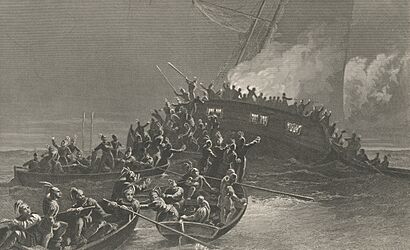
Rhode Island's history of independence made it important in the American Revolution. On June 10, 1772, a group of Providence residents attacked the British ship HMS Gaspée. They burned it because it was enforcing unpopular trade rules. Rhode Island was the first of the thirteen colonies to declare its independence from Britain on May 4, 1776. It was also the last of the thirteen colonies to approve the United States Constitution on May 29, 1790. This happened only after threats of high trade taxes from other former colonies. They also received promises that a Bill of Rights would be added to the Constitution.
During the Revolution, the British took over Newport in December 1776. American and French forces fought to remove them from Aquidneck Island. Portsmouth was where the first African-American military unit, the 1st Rhode Island Regiment, fought for the U.S. in the Battle of Rhode Island on August 29, 1778. The British left Newport in October 1779. French troops arrived in Newport on July 10, 1780. Their march to Yorktown, Virginia, in 1781 led to the British defeat.
Rhode Island was also very involved in the Industrial Revolution. This began in America in 1787. Samuel Slater set up Slater Mill in Pawtucket in 1793. He used the waterpower of the Blackstone River to run his cotton mill. For a time, Rhode Island was a leader in making textiles.
The Industrial Revolution brought many workers to cities. However, voting was limited to landowners. By 1840, only 40% of white men could vote. The state's old charter gave rural areas too much power in the government. In 1841, activists led by Thomas W. Dorr created their own state constitution. In 1842, two rival governments claimed to rule the state. Dorr's supporters started an armed rebellion. Dorr was arrested.
In response, the legislature wrote a new state constitution. It allowed American-born citizens to vote by paying a small tax, instead of owning property. This also allowed Black men to vote again. The constitution also ended slavery. However, immigrants still had to own property to vote.
Civil War
During the American Civil War, Rhode Island was the first Union state to send troops to help President Lincoln. Rhode Island provided 23,700 soldiers, and 1,685 of them died. The state's factories helped supply the Union Army. The United States Naval Academy moved to Rhode Island temporarily during the war. In 1866, Rhode Island ended racial segregation in public schools.
The Gilded Age
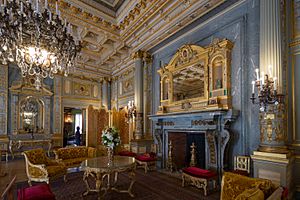
The 50 years after the Civil War were a time of great wealth and growth for Rhode Island. It was a center of the Gilded Age. Many rich industrialists built homes or summer homes there. Textile mills and factories grew, bringing many immigrants to work. This led to population growth and more cities. In Newport, New York's wealthiest people built grand mansions for summer vacations. Thousands of French-Canadian, Italian, Irish, and Portuguese immigrants came to work in the mills in Providence, Pawtucket, Central Falls, and Woonsocket.
World War I
During World War I, Rhode Island sent 28,817 soldiers, and 612 of them died. After the war, the state was greatly affected by the Spanish Influenza.
Modern Era: 1929–Present
Since the Great Depression, the Rhode Island Democratic Party has been very strong in local politics. Rhode Island has good health insurance for children from low-income families. It also has a large system to help people in need. However, many city areas still have a high rate of child poverty. More people moving from Boston has caused housing costs to rise. This has led to more homelessness in Rhode Island.
The 350th anniversary of Rhode Island's founding was celebrated with a free concert on August 31, 1986.
Geography of Rhode Island
Rhode Island is in the New England region. It is bordered by Massachusetts to the north and east, Connecticut to the west, and the Atlantic Ocean to the south. It also has a small water border with New York State. The state is about 37 miles (60 km) wide and 48 miles (77 km) long. It has a long coastline of 384 miles (618 km) along Narragansett Bay and the Atlantic Ocean.
Rhode Island is called the Ocean State and has many beaches. It is mostly flat with no real mountains. The highest point is Jerimoth Hill, which is 812 feet (247 m) above sea level. The state has two main natural areas. Eastern Rhode Island has the lowlands of Narragansett Bay. Western Rhode Island is part of the New England upland.
Narragansett Bay is a big part of the state's landscape. There are over 30 islands in the bay. The largest is Aquidneck Island, where Newport, Middletown, and Portsmouth are located. The second largest is Conanicut Island, and the third is Prudence Island. Block Island is about 12 miles (19 km) off the southern coast.
A rare rock called Cumberlandite is found only in Cumberland in the United States. It is the state rock.
- Geography of Rhode Island
Climate
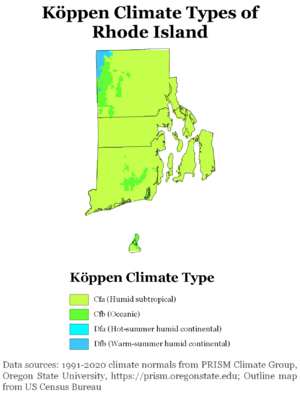
Rhode Island has warm to hot summers and cool winters with both rain and snow. Block Island has an oceanic climate. The highest temperature ever recorded in Rhode Island was 104 °F (40 °C) in Providence on August 2, 1975. The lowest was −23 °F (−31 °C) in Greene on February 5, 1996.
Rhode Island is affected by tropical storms and hurricanes because it is on the East Coast. Hurricanes that caused a lot of damage include the 1938 New England hurricane, Hurricane Carol (1954), Hurricane Donna (1960), and Hurricane Bob (1991).
Cities and Towns
Rhode Island is divided into five counties, but these counties do not have their own governments. The entire state is divided into 39 cities and towns. These handle all local government matters.
There are 8 cities and 31 towns in Rhode Island. Many major population centers grew along the Blackstone, Seekonk, and Providence Rivers. This happened when water-powered mills became popular. Providence is the center of a large metropolitan area.
The state's 19 largest cities and towns by population are:
- Providence (190,934)
- Cranston (82,934)
- Warwick (82,823)
- Pawtucket (75,604)
- East Providence (47,139)
- Woonsocket (43,240)
- Cumberland (36,405)
- Coventry (35,688)
- North Providence (34,114)
- South Kingstown (31,931)
- West Warwick (31,012)
- Johnston (29,568)
- North Kingstown (27,732)
- Newport (25,163)
- Westerly (23,359)
- Central Falls (22,583)
- Lincoln (22,529)
- Bristol (22,493)
- Smithfield (22,118)
Some of Rhode Island's cities and towns are further divided into villages. Important villages include Kingston, home to the University of Rhode Island. Wickford hosts an annual art festival. Wakefield is where the Town Hall for South Kingstown is located.
- Major cities of Rhode Island
-
1. Providence
-
2. Cranston
-
3. Warwick
-
4. Pawtucket
-
6. Woonsocket
-
7. Coventry
-
8. Cumberland
-
10. South Kingstown
-
11. Johnston
-
12. West Warwick
-
13. North Kingstown
-
14. Newport
-
15. Westerly
Famous Landmarks
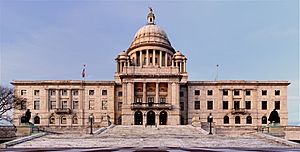
The state capitol building is made of white marble. It has the world's fourth largest marble dome that supports itself. Inside, you can see the Rhode Island Charter from 1663 and other state treasures.
The First Baptist Church of Providence is the oldest Baptist church in the Americas. It was founded by Roger Williams in 1638.
Providence has the country's first fully automated post office. Newport, a seaside city, has many historic mansions. These include The Breakers, Marble House, and Belcourt Castle. The Touro Synagogue in Newport was dedicated in 1763. It is considered the oldest existing synagogue building in the United States. It shows the religious freedoms that Roger Williams helped create. The Newport Casino is a historic building that houses the International Tennis Hall of Fame. It also has a tennis club with grass courts.
Scenic Route 1A (also called Ocean Road) is in Narragansett. "The Towers" is also in Narragansett. It has a large stone arch. It used to be the entrance to a famous casino that burned down in 1900. Today, The Towers is used for events and has a tourist information center.
The Newport Tower might have been built by Vikings, but most experts think it was a windmill from the Colonial era.
Protecting the Environment
Environmental Laws
On May 29, 2014, Governor Lincoln D. Chafee announced a plan for Rhode Island. It was one of eight states working to have 3.3 million zero-emission vehicles on their roads by 2025. This plan aims to reduce harmful gases and smog. It supports electric vehicles and the charging stations they need.
In 2014, Rhode Island received grants from the Environmental Protection Agency. These grants helped clean up contaminated sites in eight locations. This funding helps communities clean and reuse polluted properties. It also helps create jobs and protect public health.
The "Lots of Hope" program started in Providence in 2013. It focuses on increasing green spaces and local food production in the city. This program helps improve city neighborhoods and promote healthy living. It also works to make the environment more sustainable. The program turns empty city lots into urban farms.
In 2012, Rhode Island passed a law about building schools. It was the first U.S. state to stop schools from being built on contaminated sites where toxic fumes could affect air quality. It also requires public input when a city or town considers building a school on any other type of contaminated site.
On April 14, 2021, the 2021 Act on Climate was signed. This law sets goals for the state to reduce its emissions. The goal is for the state to produce net-zero emissions by 2050.
People and Population
In the 2020 U.S. census, Rhode Island had 1,097,379 people. The center of Rhode Island's population is in Cranston. Many people live in a line from Providence northwest along the Blackstone River to Woonsocket. This area grew because of 19th-century mills.
According to the 2020 census, 71.3% of the people were White. 5.7% were Black or African American. 3.6% were Asian. 9.4% were from another race, and 9.3% were from two or more races. 16.6% of the total population was of Hispanic or Latino origin.
In 2015, about 58.7% of people living in Rhode Island were born there. 26.6% were born in a different state. 12.6% were born in other countries. In 2018, the top countries for immigrants to Rhode Island were the Dominican Republic, Guatemala, Portugal, Cape Verde, and India.
Hispanics make up 12.8% of the population. Many are from the Dominican Republic, Puerto Rico, and Guatemala. Rhode Island has the highest percentage of Dominican Americans in the country.
In 2000, 84% of people aged 5 and older spoke only English at home. Other languages spoken at home included Spanish (8.07%), Portuguese (3.80%), and French (1.96%).
The percentage of non-Hispanic white people in Rhode Island has decreased. In 1970, it was 96.1%, but in 2011, it was 76.5%. In 2011, 40.3% of babies under one year old were from minority groups.
The largest ancestry groups in Rhode Island are Irish (18.3%), Italian (18.0%), English (10.5%), French (10.4%), and Portuguese (9.3%). Rhode Island has some of the highest percentages of Irish Americans and Italian Americans. Italian Americans are a large group in central and southern Providence County. French-Canadian Americans are common in northern Providence County. Irish Americans are strong in Newport and Kent counties. English Americans are still present, especially in Washington County.
Rhode Island has a notable Portuguese-speaking community. It has a higher percentage of Americans of Portuguese ancestry than any other state. This includes Portuguese Americans and Cape Verdean Americans. The state also has the highest percentage of immigrants from Liberia. African immigrants, including those from Cape Verde and Liberia, are growing communities in Rhode Island.
Rhode Island has the second highest population density of any state. Only New Jersey is more densely populated.
Religious Beliefs
| Religious affiliation per the PRRI (2022) | ||||
|---|---|---|---|---|
| Christian | 72% | |||
| Unaffiliated | 24% | |||
| Jewish | 2% | |||
| Other faiths | 2% | |||
A survey in 2014 showed that 42% of Rhode Island residents were Catholic. 30% were Protestant. 20% said they were not religious. The largest Christian groups in 2010 were the Catholic Church with 456,598 members. The Episcopal Church had 19,377 members.
Rhode Island has the highest percentage of Catholic residents of any state. This is mainly because many Irish, Italian, and French-Canadian immigrants came in the past. More recently, Portuguese and Hispanic communities have also grown.
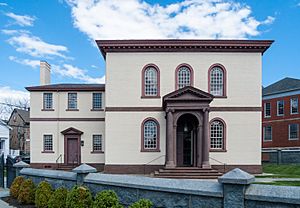
Rhode Island's Jewish community is mostly in the Providence area. It grew when many Jewish immigrants came from Eastern Europe between 1880 and 1920. The Touro Synagogue in Newport is the oldest existing synagogue in the United States. This shows that Jewish people were in Rhode Island even earlier. A smaller group of Spanish and Portuguese Jews came to Newport during the colonial era. In 2022, Jewish people made up 2% of the state's population.
People who are not religious made up 20% of the population in 2014. In 2022, this group was 24% of the population.
Native American Tribes
Today, many people in Rhode Island identify as Native American. In the 2020 census, 7,385 people identified as Native American alone. Another 15,972 identified as Native American mixed with one or more other races. Many people also reported belonging to tribes in the 2010 census. The largest groups were the Narragansett (2,820 people), the Cherokee (987), the Wampanoag (559), and the Pequot (424).
Rhode Island's Economy
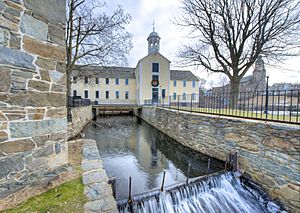
Rhode Island's early economy was based on fishing. The Blackstone River Valley was very important to the American Industrial Revolution. In Pawtucket, Samuel Slater set up Slater Mill in 1793. He used the river's power to run his cotton mill. For a while, Rhode Island was a leader in making textiles. However, during the Great Depression, most textile factories moved to southern U.S. states. The textile industry is still part of Rhode Island's economy, but it is not as powerful as it once was.
Other important industries in Rhode Island's past included making tools, costume jewelry, and silverware. Many old factories are now apartments, museums, offices, or housing for low-income people and seniors. Today, much of Rhode Island's economy relies on services, especially healthcare and education. Manufacturing is still important, including building nuclear submarines.
In 2013, Rhode Island had the highest-paid elementary school teachers in the country. Their average salary was $75,028.
The main office of Citizens Financial Group, a large bank, is in Providence. The big companies CVS Caremark and Textron are based in Woonsocket and Providence. Other large companies based in Rhode Island include FM Global, GTECH Corporation, Hasbro, and Amica Mutual Insurance.
According to the Bureau of Economic Analysis, Rhode Island's total economic output in 2024 was $82.5 billion. Rhode Island uses the least amount of energy per person of any state. It is also rated as the 5th most energy-efficient state. In November 2019, the unemployment rate was 3.5%. The coronavirus pandemic caused it to rise to 18.1% in April 2020. By September 2020, it had dropped to 10.5%.
Health services are Rhode Island's biggest industry. Tourism is the second largest, supporting 39,000 jobs. Manufacturing is the third largest industry. Its products include submarine construction, shipbuilding, and electrical equipment. Rhode Island's farms produce nursery plants, vegetables, dairy products, and eggs. The largest farm product is milk.
Rhode Island's taxes used to be higher than nearby states. In 2010, the state government passed a new income tax law. This made Rhode Island more competitive with other New England states by lowering its top tax rate to 5.99%.
Transportation
Bus Travel
The Rhode Island Public Transit Authority (RIPTA) runs buses across the state. Their main stations are in Providence, Pawtucket, and Newport. RIPTA buses serve 38 of Rhode Island's 39 cities and towns. They operate 58 routes, including trolley-style buses in Providence and Newport.
Ferry Service
RIPTA used to offer seasonal ferry service between Providence and Newport. This service was popular but stopped when federal funding ended. It started again in 2016. The privately run Block Island Ferry connects Block Island with Newport and Narragansett. The Prudence Island Ferry connects Bristol with Prudence Island. Other private ferries link Rhode Island with ports in Connecticut, Massachusetts, and New York.
Train Travel
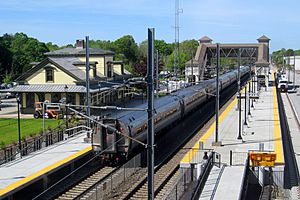
The MBTA Commuter Rail connects Providence and T. F. Green Airport with Boston. It also stops in Pawtucket/Central Falls and Massachusetts. The line was extended south to Wickford Junction in 2012. The state has thought about extending the MBTA line to Kingston and Westerly. They are also looking into light-rail or rapid bus transit in some cities.
The Federal government's Amtrak Acela Express stops at Providence Station. This links Providence to other cities in the Northeast Corridor. Amtrak's Northeast Regional service stops at Providence Station, Kingston, and Westerly.
Rhode Island has high-speed train tracks that can handle speeds of 165 mph. This was done in the 1990s to prepare for the high-speed Acela Express trains.
Air Travel
Rhode Island's main airport for passengers and cargo is T. F. Green Airport in Warwick. However, many Rhode Islanders who want direct international flights or more flight options often fly from Logan International Airport in Boston.
Major Highways

Interstate 95 (I-95) crosses the state from southwest to northeast. It connects Rhode Island with other states along the East Coast. I-295 goes around Providence to the west. I-195 connects Providence to Cape Cod. A part of U.S. Route 6 also links I-295 with downtown Providence.
Other Rhode Island highways include Route 4, which connects Providence and Warwick to beach towns. Route 10 links downtown Providence with Cranston and Johnston. Route 37 is an important east-west highway through Cranston and Warwick. Route 99 connects Woonsocket with Providence. Route 146 goes through the Blackstone Valley to Worcester, Massachusetts. Route 403 links Route 4 with Quonset Point.
Several bridges cross Narragansett Bay. The most famous are the Claiborne Pell Newport Bridge and the Jamestown-Verrazano Bridge.
Bicycle Paths
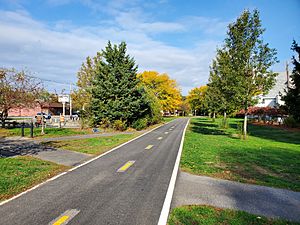
The East Bay Bike Path goes from Providence to Bristol along Narragansett Bay. The Blackstone River Bikeway will eventually connect Providence and Worcester. In 2011, Rhode Island finished a bike path through Pawtucket and Providence. This path connects the East Bay Bike Path with the Blackstone River Bikeway. This creates a 33.5-mile (53.9 km) bike route. The William C. O'Neill Bike Path is an 8-mile (13 km) path through South Kingstown and Narragansett. The 19-mile (31 km) Washington Secondary Bike Path goes from Cranston to Coventry. The 2-mile (3.2 km) Ten Mile River Greenway path runs through East Providence and Pawtucket.
Future Plans
In late 2019, the Rhode Island Public Transit Authority shared a plan for public transit improvements by 2040. Ideas included a bus rapid transit system, express bus routes, and expanding train services. They also considered building a new light rail network in downtown Providence.
Education
Colleges and Universities
Rhode Island has several colleges and universities:
- Brown University
- Bryant University
- Community College of Rhode Island
- Johnson & Wales University
- Naval War College
- New England Institute of Technology
- Providence College
- Rhode Island College
- Rhode Island School of Design
- Roger Williams University
- Salve Regina University of Newport
- University of Rhode Island
Culture
Local Accent and Words
Some Rhode Islanders speak with a special accent. It is a mix of New York City and Boston accents. For example, "water" might sound like "watuh." Many Rhode Islanders say the "aw" sound strongly, like in "coffee." Rhode Islanders sometimes call drinking fountains "bubblers." They call milkshakes "cabinets" and long sandwiches "grinders."
Food and Drinks
Rhode Island, like other New England states, has a tradition of clam chowder. Both the white New England and red Manhattan kinds are popular. There is also a special clear-broth chowder called Rhode Island Clam Chowder. A popular food is the clam cake, a deep-fried ball of dough with chopped clams inside. They are sold in seafood restaurants. A classic summer meal in Rhode Island is chowder and clam cakes.
The quahog is a large local clam. It is often used in chowder. It is also ground up and mixed with stuffing or spicy sausage. Then it is baked in its shell to make a stuffie. Calamari (squid) is sliced and fried as an appetizer in Italian restaurants. It is often served with banana peppers and marinara sauce. In 2014, calamari became the official state appetizer. Clams Casino was invented in Rhode Island.
The official state drink of Rhode Island is coffee milk. This drink is made by mixing milk with coffee syrup. This unique syrup was invented in the state. Johnnycakes have been a Rhode Island food since Colonial times. They are made with corn meal and water, then pan-fried like pancakes.
Long sandwiches are called grinders in Rhode Island. The Italian grinder, made with cold meats and cheese, is very popular. Linguiça or chouriço is a spicy Portuguese sausage often eaten with peppers and bread.
Rhode Island State Symbols
| Bird | Rhode Island Red chicken Gallus gallus domesticus |
|---|---|
| Fish | Striped bass |
| Flower | Blue Violet Viola sororia |
| Fruit | Rhode Island Greening |
| Tree | Red Maple Acer rubrum |
| Insect | American burying beetle Nicroforus americanus |
Rhode Island in Pop Culture
The Farrelly brothers and Seth MacFarlane often show Rhode Island in popular culture. MacFarlane's TV show Family Guy is set in a made-up Rhode Island city called Quahog. The show often makes jokes about local events and famous people.
The 1956 movie High Society was set in Newport, Rhode Island. The 1974 movie The Great Gatsby was also filmed in Newport.
Jacqueline Bouvier and John F. Kennedy were married in Newport.
Cartoonist Don Bousquet is a state icon. He draws cartoons about Rhode Island culture for The Providence Journal and Yankee magazine.
The 1998 movie Meet Joe Black was filmed at Aldrich Mansion in Warwick. The TV series Brotherhood is set in Rhode Island. Body of Proofs first season was filmed entirely in Rhode Island. The 2007 movie Dan in Real Life was filmed in coastal towns in the state.
Jersey Shore star Pauly D filmed part of his show The Pauly D Project in his hometown of Johnston. The Comedy Central show Another Period is set in Newport during the Gilded Age.
Notable Firsts in Rhode Island
Rhode Island has been first in many things. The Colony of Rhode Island and Providence Plantations passed the first law against slavery in America on May 18, 1652.
The first armed rebellion against the British Crown in America happened in Narragansett Bay. This was when the ship HMS Gaspée was boarded and burned on June 10, 1772. The idea of a Continental Congress was first suggested in Providence on May 17, 1774. Rhode Island was the first Colony to declare independence from Britain on May 4, 1776.
Slater Mill in Pawtucket was the first successful cotton-spinning mill in America with machines. It was the birthplace of the Industrial Revolution in the U.S. The oldest Fourth of July parade in the country is still held every year in Bristol, Rhode Island. The first Baptist church in America was founded in Providence in 1638. Ann Smith Franklin was the first female newspaper editor in America (August 22, 1762). Touro Synagogue is the oldest synagogue in America, founded in Newport in 1763.
Pelham Street in Newport was the first street in America to be lit by gaslight in 1806. The first strike in the United States where women took part happened in Pawtucket in 1824. Watch Hill has the nation's oldest carousel with flying horses, running since 1850. The motion picture machine was patented in Providence on April 23, 1867. The first lunch wagon in America was introduced in Providence in 1872. The first nine-hole golf course in America was finished in Newport in 1890. The Rhode Island State House was the first building with an all-marble dome in the United States (1895–1901). The first car race on a track was held in Cranston on September 7, 1896.
Other Local Culture
Rhode Island is called "The Ocean State." Its geography, with lots of water, is a big part of its culture. Newport Harbor has many pleasure boats. The state's main airport, T. F. Green Airport, has a large sailboat in its lobby. The state's license plates show an ocean wave or a sailboat.
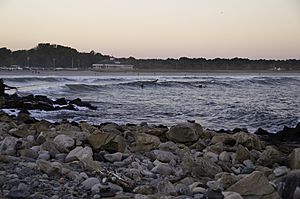
Many Rhode Islanders go to Washington County for summer vacations because of its many beaches.
The state constitution protects access to the shore for swimming and gathering seaweed. However, there have been conflicts over beach access.
Rhode Islanders developed a unique style of architecture in the 1600s called the stone-ender.
Rhode Island is the only state that still celebrates Victory over Japan Day. It is officially called "Victory Day" and is celebrated on the second Monday in August.
Nibbles Woodaway, also known as "the Big Blue Bug," is a 58-foot-long termite mascot. It is for an extermination business in Providence. Since it was built in 1980, it has been in movies and TV shows. Many locals see it as a cultural landmark. During the COVID-19 pandemic, the Big Blue Bug wore a mask to remind people to wear theirs.
Music
On September 2, 1977, the Beach Boys played a concert at Narragansett Park in Pawtucket, Rhode Island. 40,000 people attended, making it the largest concert audience in Rhode Island history. In 2017, the street where the stage stood was officially renamed "Beach Boys Way."
In April 1986, the music charity Bandwagon was started in Rhode Island. On May 11, 1986, a group of 150 celebrities recorded a charity song called “A Piece of Our Hearts.” The goal was to raise money for groups that help hungry and homeless people in America. The project received national recognition and won an award for public service.
Sports
Professional Teams
Rhode Island has two professional minor league teams. The Providence Bruins ice hockey team plays in the American Hockey League. They are connected to the Boston Bruins. They play in the Amica Mutual Pavilion in Providence. They won the AHL's Calder Cup in 1999.
Rhode Island FC is a soccer team. They started playing in the USL Championship in 2024 at Beirne Stadium. They are waiting for their new stadium, Tidewater Landing Stadium, to be finished in Pawtucket for the 2025 season.
The Pawtucket Red Sox baseball team was a Triple-A team connected to the Boston Red Sox. They played at McCoy Stadium in Pawtucket from 1973 to 2020. They won four league titles. McCoy Stadium also hosted the longest professional baseball game ever played, which lasted 33 innings.
The Providence Reds were a hockey team that played from 1926 to 1977. They won the Calder Cup four times. The team's name came from the state bird, the Rhode Island Red rooster. They moved to New York in 1977 and are now called the Hartford Wolf Pack. The Reds are the oldest continuously playing minor-league hockey team in North America. The AHL returned to Providence in 1992 with the Providence Bruins.
The Providence Grays won the first World Championship in baseball history in 1884. They played in the National League from 1878 to 1885. They beat the New York Metropolitans to become the first major league baseball champions. Babe Ruth played for the minor league Providence Grays in 1914.
Rhode Island has a long history with soccer. The state's first organized league, the Rhode Island Football Association (RIFA), was founded in 1886. One of their teams, the Pawtucket Free Wanderers, won the American Cup in 1893. The first championship game of the U.S. Open Cup was held in Pawtucket in 1914. Later, the Pawtucket Rangers F.C. won the 1941 U.S. Open Cup.
The now-defunct professional football team, the Providence Steamrollers, won the 1928 NFL title. An unrelated basketball team also called the Providence Steamrollers played in the league that became the National Basketball Association.
Rhode Island's only rugby league team was the Rhode Island Rebellion. They played at Classical High School in Providence.
College and Amateur Sports
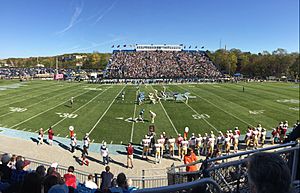
There are four NCAA Division I schools in Rhode Island. They all play in different conferences. The Brown University Bears are in the Ivy League. The Bryant University Bulldogs are in the America East Conference. The Providence College Friars are in the Big East Conference. The University of Rhode Island Rams are in the Atlantic 10 Conference. Three of these schools have football teams that play in the NCAA Division I Football Championship Subdivision.
From 1930 to 1983, America's Cup sailing races were held off Newport. The extreme-sport X Games and Gravity Games were started and hosted in Providence.
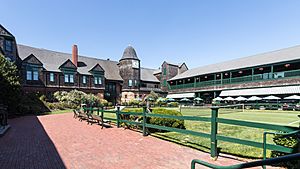
The International Tennis Hall of Fame is in Newport. It is at the Newport Casino, where the first U.S. National Championships were held in 1881. The Hall of Fame was created in 1954.
Rhode Island is also home to the American Youth Rugby League Association (AYRLA). This group governs youth rugby league in the United States.
Government
The capital of Rhode Island is Providence. The state's governor is Daniel McKee (D). The lieutenant governor is Sabina Matos (D). Gina Raimondo became Rhode Island's first female governor in November 2014. Rhode Island's United States senators are Jack Reed (D) and Sheldon Whitehouse (D). Its two United States representatives are Gabe Amo (D-1) and Seth Magaziner (D-2).
The state legislature is the Rhode Island General Assembly. It has the 75-member House of Representatives and the 38-member Senate. The Democratic Party controls both parts of the legislature. The Republican Party has only a few seats.
Elections
Rhode Island's population is just above the minimum needed for extra votes in the federal House of Representatives and Electoral College. It has a good number of electoral votes and House Representatives for its population. Based on its size, Rhode Island has the highest density of electoral votes of any state.
In presidential elections, Rhode Island usually votes for the Democratic candidate. The state voted Republican until 1908. Since then, it has voted Republican seven times and Democratic 17 times. In the last 16 presidential elections, the Democratic Party has won Rhode Island's Electoral College votes 12 times. In the 1980 presidential election, Rhode Island was one of six states that did not vote for Republican Ronald Reagan. Reagan was the last Republican to win any of the state's counties in a Presidential election until Donald Trump won Kent County in 2016. In 1988, George H. W. Bush received over 40% of the state's popular vote. No Republican has done that since.
Rhode Island was the top state for Democrats in 1960, 1964, 1968, 1988, and 2000. In 2004, Rhode Island gave John Kerry a more than 20-percentage-point lead. In 2008, Rhode Island gave Barack Obama a 28-percentage-point lead. All but one of Rhode Island's 39 cities and towns voted for the Democratic candidate (the exception was Scituate).
In a 2020 study, Rhode Island was ranked as the 19th easiest state for citizens to vote in.
Laws and Taxes
Rhode Island is one of 21 states that have ended capital punishment (the death penalty). It was the second state to do so, after Michigan. Its last execution was in the 1840s.
Rhode Island became the eighth state to recognize same-sex marriage or civil unions. Same-sex marriage became legal on May 2, 2013.
Rhode Island has some of the highest taxes in the country, especially property taxes. It ranks seventh in local and state taxes and sixth in real estate taxes.
Famous People from Rhode Island
- Thomas Angell (1618–1694) – helped found the Colony of Rhode Island and Providence Plantations
- John Clarke (1609–1676) – Baptist minister, helped found the Colony of Rhode Island and Providence Plantations, and supported religious freedom
- William Coddington (1601–1678) – early leader and governor of the colony
- William Ellery (1727–1820) – signed the United States Declaration of Independence for Rhode Island
- Nathanael Greene (1742–1786) – a general in the Continental Army, considered one of George Washington's best officers
- Stephen Hopkins (1707–1785) – Governor of Rhode Island and signed the Declaration of Independence
- Anne Hutchinson (1591–1643) – early settler of Newport, known for her religious views
- H. P. Lovecraft (1890–1937) – author
- Oliver Hazard Perry (1785–1819) – naval commander and hero of the War of 1812
- Samuel Slater (1768–1835) – industrialist, known as the "father of the industrial revolution"
- Gilbert Stuart (1755–1828) – painter, famous for portraits
- Roger Williams (1603–1684) – founder of the Colony of Rhode Island and Providence Plantations, supported the idea of separating church and state
Images for kids
-
Köppen climate types of Rhode Island, using 1991–2020 climate normals
See also
 In Spanish: Rhode Island para niños
In Spanish: Rhode Island para niños



